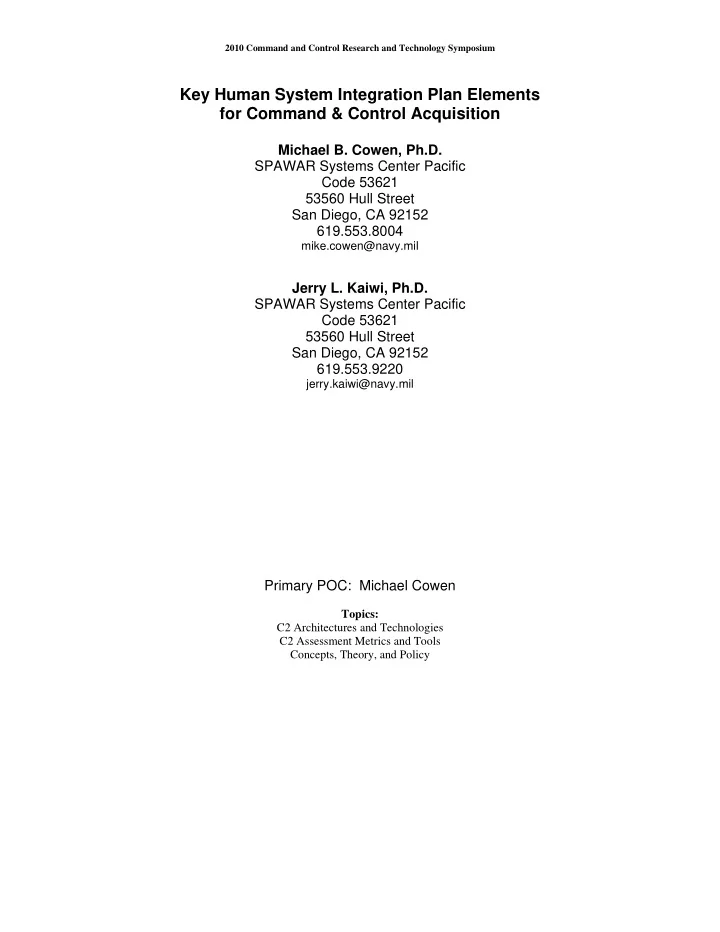

2010 Command and Control Research and Technology Symposium Key Human System Integration Plan Elements for Command & Control Acquisition Michael B. Cowen, Ph.D. SPAWAR Systems Center Pacific Code 53621 53560 Hull Street San Diego, CA 92152 619.553.8004 mike.cowen@navy.mil Jerry L. Kaiwi, Ph.D. SPAWAR Systems Center Pacific Code 53621 53560 Hull Street San Diego, CA 92152 619.553.9220 jerry.kaiwi@navy.mil Primary POC: Michael Cowen Topics: C2 Architectures and Technologies C2 Assessment Metrics and Tools Concepts, Theory, and Policy
2010 Command and Control Research and Technology Symposium Key Human System Integration Plan Elements for Command & Control Acquisition Michael B. Cowen Jerry L. Kaiwi Abstract As the Navy transitions to the guiding principles of Net-Centric Warfare, it is imperative to recognize the importance to access vital, secure and timely tactical information in any given battlespace. The Space and Naval Warfare Systems Command is the acquisition lead for several systems that will create a highly adaptive, networked and distributed defense force with the increased speed, agility and security required to support constantly evolving mission needs. The systems will provide the commander the ability to make more timely and informed decisions based upon the best information and practices. Human System Integration (HSI) is a system engineering process designed to ensure that human performance related issues are identified early in the acquisition process and mitigated during system development and testing using appropriate performance metrics and data collection methods. HSI activities are guided by an acquisition Human System Integration Plan (HSIP) that identifies and integrates design requirements for (a) Human Factors Engineering, (b) Personnel, (c) Habitability, (d) Manpower, (e) Training, (f) Safety & Occupational Health, and (g) Survivability. Key elements of HSI for Command & Control acquisition include: (1) top- down functional analysis/allocation, (2) task-centered design, (3) cognitive engineering, and (4) knowledge mapping. Introduction As the Navy transitions to the guiding principles of Net-Centric Warfare, it is imperative to recognize the importance to access vital, secure and timely tactical information in any given operational theater. The Navy’s Space and Naval Warfare Systems Command (SPAWAR) is the lead organization responsible for transforming information technology in the military maritime domain (Gallagher, 2010). SPAWAR through their research and development centers and support activities is responsible for providing development, testing and acquisition of systems for future Navy command, control, communications, computers, intelligence, surveillance and reconnaissance products. They are the acquisition lead for several systems that will create a highly adaptive, networked and distributed naval force with the increased speed, agility and security required to support constantly evolving mission needs. These systems will provide the operational commanders the ability to make more timely and informed decisions based upon the best information and practices. Human Systems Integration Human Systems Integration (HSI) is a formal acquisition process that provides techniques for human performance in mission capability definition and system development. It is a system engineering practice designed to ensure that human performance related issues are identified early in the acquisition lifecycle and mitigated during system development and testing using appropriate performance metrics and data collection methods. HSI integrates human capabilities and limitations into system definition, design, development and evaluation to optimize total system performance in operational environments. DoD Instruction 5000.2 requires a comprehensive plan for HSI to be in place early in the acquisition process that will optimize total system performance, minimize total ownership costs, and ensure that the final product is built to accommodate the user population characteristics for operations, maintenance and logistics.
2010 Command and Control Research and Technology Symposium There are seven HSI areas that must be considered before existing technology is modernized or new technologies are acquired and deployed: Human Factors Engineering, Personnel, Habitability, Manpower, Training, Safety & Occupational Health, and Survivability (see Table 1 for examples). The HSI process incorporates the seven domains into the systems acquisition process. The goal of the development is an effective system requiring minimal training for the user, prioritization of information necessary for the decision making process, and interfaces that effectively manage and simplify operator workload, are intuitive to use, and provide for user customization where feasible. These domains are interdependent and best HSI practices optimize the mix of these elements based on discovered interdependencies and trade-offs that balance performance and cost. Human Factors Engineering (HFE) HFE focuses on designing human system interfaces to optimize user performance and reduce the likelihood of user errors. HFE designs should minimize or eliminate system characteristics that require excessive cognitive, physical, and sensory skills; entail extensive training or workload intensive tasks; result in mission-critical errors; or produce safety or health hazards. Domains Human Factors Personnel Habitability Manpower Training Safety & Survivability Engineering Occupational Health Interface Knowledge, Skills Quality of Work Officer, Enlisted, Initial, Follow ‐ on, & Accident Damage Control Design & Abilities Civilian Billets Refresher Avoidance Quality of Life Personnel Workload Personnel Wartime Delivery Systems Health Hazards Protection Environmental Classification Requirements Situation Limits and Embedded Training Risk Mitigation Fratricide Awareness Selection Controls Peacetime Distance Learning Medical Requirements Decision ‐ Support Recruiting Individual Retention Team Human Systems Integration Design Requirements Table 1. Human Systems Integration Design Requirements. Personnel Knowledge, skills, and abilities are identified to operate, maintain, and sustain the system. The human performance characteristics of the user population are assessed based on the system description, projected characteristics of target occupational specialties, and recruitment and retention trends. To the extent possible, system functionality shall not require cognitive, physical, or sensory skills beyond that found in the specified user population. Habitability Requirements are established for the physical environment that impact system performance related quality of life and morale which may affect personnel recruitment or retention.
Recommend
More recommend